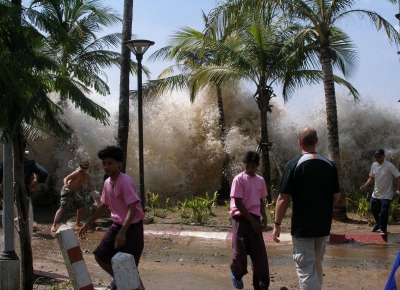The 1343 tsunami struck the Tyrrhenian Sea and Bay of Naples on November 25, 1343. Underground shocks were felt in Naples and caused significant damage and loss of lives. Of major note was a tsunami created by the earthquake which destroyed many ships in Naples and destroyed many ports along the Amalfi Coast including Amalfi itself. The effects of the tsunami were observed by the poet Petrarch, whose ship was forced to return to port, and recorded in the fifth book of his Epistolae familiares. A 2019 study attributes the event to a massive submarine landslide (possibly greater than 1 km3), caused by flank collapse of the Stromboli volcano.
A tsunami ( (t)soo-NAH-mee, (t)suu-; from Japanese: 津波, lit. 'harbour wave', pronounced [t͡sɨᵝna̠mʲi]) is a series of waves in a water body caused by the displacement of a large volume of water, generally in an ocean or a large lake. Earthquakes, volcanic eruptions and other underwater explosions (including detonations, landslides, glacier calvings, meteorite impacts and other disturbances) above or below water all have the potential to generate a tsunami. Unlike normal ocean waves, which are generated by wind, or tides, which are generated by the gravitational pull of the Moon and the Sun, a tsunami is generated by the displacement of water by a large event.
Tsunami waves do not resemble normal undersea currents or sea waves because their wavelength is far longer. Rather than appearing as a breaking wave, a tsunami may instead initially resemble a rapidly rising tide. For this reason, it is often referred to as a tidal wave, although this usage is not favoured by the scientific community because it might give the false impression of a causal relationship between tides and tsunamis. Tsunamis generally consist of a series of waves, with periods ranging from minutes to hours, arriving in a so-called "wave train". Wave heights of tens of metres can be generated by large events. Although the impact of tsunamis is limited to coastal areas, their destructive power can be enormous, and they can affect entire ocean basins. The 2004 Indian Ocean tsunami was among the deadliest natural disasters in human history, with at least 230,000 people killed or missing in 14 countries bordering the Indian Ocean.
The Ancient Greek historian Thucydides suggested in his 5th century BC History of the Peloponnesian War that tsunamis were related to submarine earthquakes, but the understanding of tsunamis remained slim until the 20th century, and much remains unknown. Major areas of current research include determining why some large earthquakes do not generate tsunamis while other smaller ones do. This ongoing research is designed to help accurately forecast the passage of tsunamis across oceans as well as how tsunami waves interact with shorelines.

 English
English  español
español  français
français  português
português  русский
русский  العربية
العربية  简体中文
简体中文 
